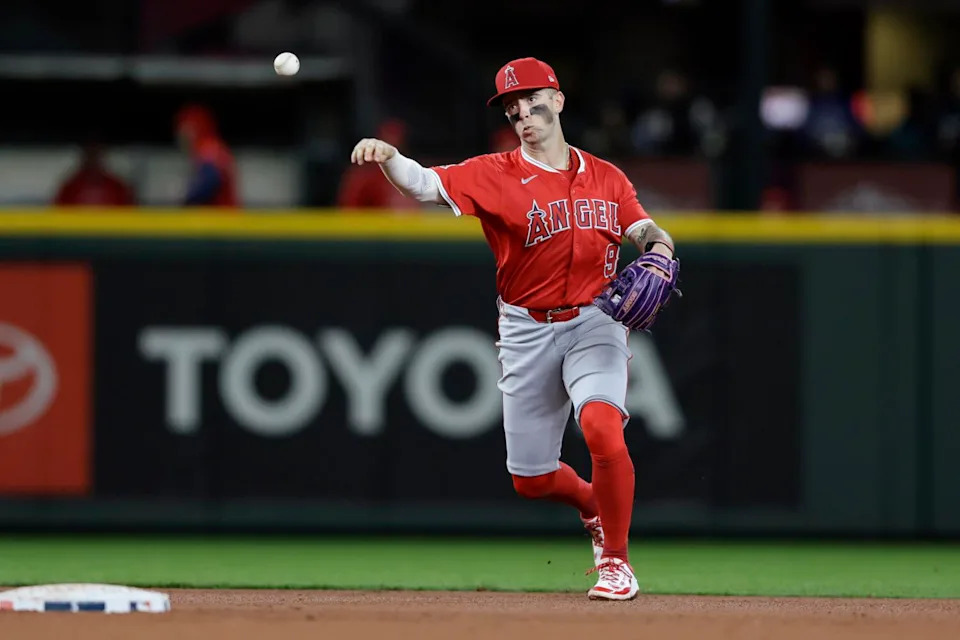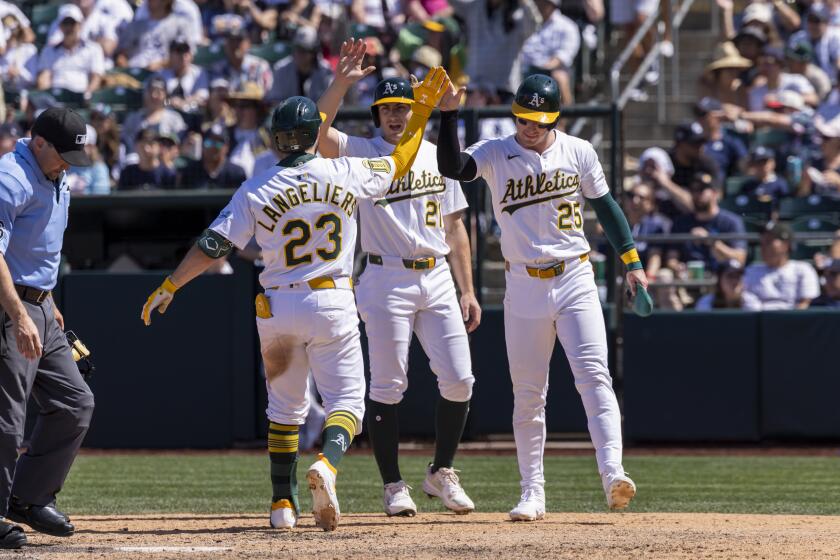No team has won a series from the Dodgers this month until the Angels swept them over the weekend. For the Angels, a great weekend.
On one hand, maybe this is the start of something big. The Minnesota Twins just put up a 13-game winning streak. Why can’t the Angels?
On the other hand, the Angels just swept the world’s best team and they still are in last place.
No team had a gloomier outlook than the Athletics this time last year, coming off back-to-back 100-loss seasons and playing out a somber final season at the Oakland Coliseum. But the A’s finished ahead of the Angels last season, and the A’s are ahead of the Angels again this season.
Read more: Angels defeat Shohei Ohtani and rival Dodgers, but they aspire for much more
The A’s rebuild all the time: build, win, lose the best players and lose lots of games, rebuild. For all of this century, A’s ownership has maintained it could not spend big without big revenue from a new stadium. When the A’s get to Las Vegas in three or four years, we’ll see.
The A’s never have spent $70 million on a contract, or $100 million on an annual team payroll. In this century, however, they have more postseason appearances and more winning seasons than the Angels.
After the 2021 season — a fourth consecutive winning season that included three playoff berths — the A’s decided it would cost them too much to keep winning. The owners locked out players that winter, and the wrecking ball hit as soon as the lockout ended.
“Within the first hour,” A’s manager Mark Kotsay said last week at Dodger Stadium, “we had traded Matt Olson.”
The Atlanta Braves acquired Olson, an All-Star first baseman, to replace Freddie Freeman. By week’s end, the A’s had traded two other All-Stars, third baseman Matt Chapman and pitcher Chris Bassitt. By year’s end, they also had traded pitcher Sean Manaea and catcher Sean Murphy.
“That made it very difficult to bounce back quickly without being able to use the free-agent market,” general manager David Forst said.
The Olson trade brought back catcher and cleanup batter Shea Langeliers. The Chapman and Bassitt trades each netted a back-end starting pitcher, Gunnar Hoglund and J.T. Ginn.
Brent Rooker hits a two-run home run against the Yankees on May 10. (Sara Nevis / Associated Press)
“Those are the types of trades we have to hit on to have success,” Kotsay said.
And, without being able to use the free-agent market, the A’s also had to find success with draft picks and waiver claims.
“I’m an example of that,” All-Star outfielder Brent Rooker said. “I was a waiver claim, came in, took advantage, and played well enough to continue to earn at-bats.
“The people here have played a huge part in my development and my success the last few years, to turn what was viewed as a 4-A, roster depth guy into a productive big leaguer.”
The Dodgers do that all the time: Max Muncy, Evan Phillips, Chris Taylor.
David Eckstein, the shortstop on the Angels’ 2002 World Series championship team, was a waiver claim. The Angels hoped that outfielder Mickey Moniak, a first-round pick of the Philadelphia Phillies, might blossom with opportunity and a change of scenery; he turned out to be what Rooker had been told he was.
Of the A’s top picks in the past five drafts, three play prominent roles now: outfielder Tyler Soderstrom and infielders Nick Kurtz and Jacob Wilson. A fourth, infielder Max Muncy (no relation to the Dodgers’ Max Muncy), has split time this season between triple A and the majors.
They’re all 22 or 23 years old. Forst quickly credited the A’s longtime scouting director, Eric Kubota.
“When you look at our team now, it is clear what an outstanding job Eric and his team have done in the draft the last five years,” Forst said.

Angels shortstop Zach Neto makes a throws to first base against the Seattle Mariners on April 29. (John Froschauer / Associated Press)
The Angels can take a few bows in these areas. Shortstop Zach Neto, a first-round draft pick, is emerging as one of the best players in the American League. Neto, catcher Logan O’Hoppe (trade) and first baseman Nolan Schanuel (first-round draft pick) are the only three Angels to play in at least half the team’s games and perform above the league average.
However, on the night I visited with the A’s last week, Rooker batted third and Langeliers batted fourth, and no one in the starting lineup nor the starting pitcher was older than 30.
That same night for the Angels, veteran stopgaps Yoán Moncada and Jorge Soler batted third and fourth, respectively. Of their 10 starters that night, including the pitcher, five were older than 30.
And, of the 10 starters for the Angels’ triple-A team that night, one was drafted by the team. He was a 13th-round pick, batting eighth.
The Angels’ starting pitchers have been healthy, but on that front the team is a couple injuries from potential disaster.
In the 2021 draft, the Angels attempted to shore up an organizational weakness by drafting all pitchers, all but one of the 21 from college rather than high school and thus closer to the majors. The combined WAR of the two that made it to Anaheim: 0.6.
Read more: The future of Angel Stadium? Anaheim puts the issue on hold
The A’s organizational winning percentage (the combined record of their minor league teams) ranked fourth among the 30 teams entering play Sunday, with a better run differential than any organization except the Milwaukee Brewers, according to J.J. Cooper of Baseball America.
The Angels’ organizational winning percentage ranked 27th, with a worse run differential than any organization except the Washington Nationals. (The best organizational winning percentage? The Dodgers, of course, tied with the Brewers.)
What the Angels need most are high-end prospects, such as Dodgers outfielder Andy Pages, whom the Angels had agreed to acquire in a 2020 trade vetoed by owner Arte Moreno, and like the ones they could have acquired for Shohei Ohtani in 2022 or 2023. No veteran on the Angels’ active roster would command high-end prospects in return.
Moreno chose to try to win with Ohtani, even after Ohtani had declined to discuss an extension in the year before free agency. Moreno always chooses to try to win, in the name of fans whom he believes would not want to sit through a 100-loss season.
Trouble is, the Angels lost 99 games last season, with too many veteran placeholders and not enough prospects, and attendance fell anyway.
The Angels this season are paying the injured Mike Trout and Anthony Rendon just about as much as the A’s are paying their entire roster. Fangraphs on Sunday put the A’s chance of making the playoffs at 10.7% and the Angels’ chance at 0.8%.
Read more: Shaikin: Zach Neto isn’t Mike Trout, but he might be capable of saving the Angels
The A’s, with their collection of rising position players, could have been an attractive destination for the affordable and talented Roki Sasaki, who chose the Dodgers.
“There were places he specifically wanted to play,” Forst said, “and Sacramento was not on his list.”
Rebuilds take time, and the A’s are not at the finish line yet. The Angels are treading water until Rendon’s contract expires in 2026 — the same year Neto and O’Hoppe become eligible for salary arbitration. Being active is one thing. Being proactive is quite another.
Get the best, most interesting and strangest stories of the day from the L.A. sports scene and beyond from our newsletter The Sports Report.
This story originally appeared in Los Angeles Times.
Read the full article here

